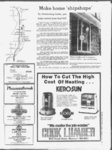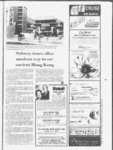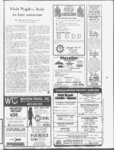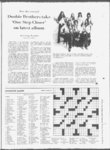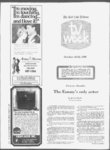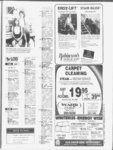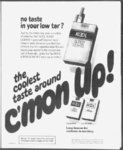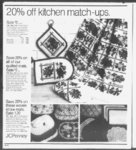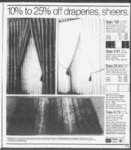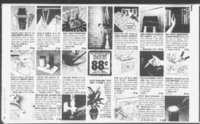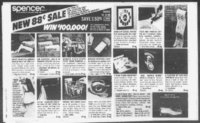| OCR Text |
Show Winners in Civic Beautification Awards Program received their awards at ceremony and tea at Garden Club Center in Sugar House Park. Civic Beautification Awards Program Winners gather . . . their efforts praised H. Folsom by Genevieve Tribune Garden Editor THIRTY-EIGHplaques were presented to Civic Beautification Awards Program state winners at a recent ceremony and tea at the Garden Club Center in Sugar House Park. Eight regional plaques were given to winners for the best entries in each district. One hundred and twenty-si- x improvement bars were presented to those who continued to keep up their projects after winning a state plaque. Three hundred certificates went to those who won in districts. Awards for special efforts were presented to Afton Taylor, Bicknell; City of Enterprise; Allen Johnson, Grantsville; and the City of Richmond. For activity in the beautification effort, awards were given to Cula Ekker, Bicknell, Nancy Sorenson, Loa; Linda Lohrengel, Ephraim; and Jeannine Holt, Enterprise. THOSE RECEIVING plaques were Hogle Zoological Gardens, Liberty Park, Lake Pines Community Apts.; Robert W. and Naomi N. Brems; Utah State Capitol; Lee Bums, all of Salt Lake City. Other winners included; Murray City Corporation; 47th South tree planting, Taylorsville; Inmate Business State Prison; Association, Medium Security-Uta- h City of Tooele; James and Helen Wexels, Maxine Nelson, both of Tooele; City of Grantsville; American Fork 4, 15 and 19th Wards; Sundance, Provo Canyon; T Kenneth E. Abel, Provo; Mr. and Mrs. Wilford Gottfredson, Springville; Carl A. and Sylvia B. Lee, Salem; Glen J. Ward, North Ogden; Layton City Commons, Layton; Millstream Garden Apartments; Bountiful; LaRue Peterson, Logan; and Joe and Phyllis.Henderson, Brigham City. Also receiving plaques were Ruth King, Ephraim ; Mr. and Mrs. Dean N. Johansen, Mount Pleasant; LoRee Sorenson, Loa; Wilford Jenson, Fillmore; Sharon and Lorene Lamb, Orderville; Preston Nutter Ranch, Nine Mile Canyon; Karl and Phyllis Truman, Minersville; Brent Price, New Harmony; Ferrol and Karen Tait, Enterprise; Pat and Bruce Forsyth, Cedar City; City of St. George, St. George LDS Temple and Mr. and Mrs. Kline Adams, St. George; Dinosaur National History Museum, Vernal. Regional plaques were awarded to Mr. and Mrs. Lawrence Winder, Sandy; Hillcrest neighborhood beautification project, Springville; Paul W. Flint, Layton; Cove Ward, Richmond; LaVem Taft, Bicknell; Mr. and Mrs. Ross Hilton, Cedar City; City of Orderville; and Roosevelt Park. THE NURSERYMENS Special awards of block tree plantings valued at approximately $500 each for the most entries in the under 3,000 population went to Ephraim and Minersville, which tied for the honor. The judges selected St. George as the city making the most progress in a single year. It too received a block tree planting. Presenting the awards were Dr. Wayne Rose, area coordinator of Salt Lake and Tooele counties and state director of the Civic Beautification Program for the Utah State University extension services; John Cummins, Community Service Director, The Salt Lake Tribune; Genevieve H. Folsom, Tribune Garden Editor; Lon Clayton, president, Utah Association of Nurserymen and Mrs. Robert Mark Savage, Rocky Mountain Region Director, National Council of State Garden Clubs, Inc., representing the Utah Associated Garden Clubs. Hosts and hostesses were Mr. and Mrs. Theodore Burnham, Mrs. Fred Augsburger and Mrs. Wilford Biesinger. Mrs. D. G. Colman, Mrs. Bessie Bartholomew and Mrs. Walter Christensen were in charge of the tea. Assisting were Mrs. Don C. Gee, Mrs. Era Wade, Mrs. H. C. Wagner, Mrs. Douglas Ridges, Mrs. Maria Noble, Mrs. Maxine Hamby, Mrs. Elmer Alston, Mrs. H. K. Bullen, Mrs. Melvjn L. Memmott, Karen Coleman, Colleen Folsom and Katie Folsom. A SLIDE PROGRAM of was presented by Dr. Wayne Rose. prize-winnin- g gardens fl The plant doctor When to pick apples Arvil L. Stark by Dr. Tribune Garden Consultant APPLES THAT are to be stored should be harvested earlier than those for immediate use. Allowing the fruit to remain on the tree until it is fully ripe shortens the time it can be held in storage. There are precise methods of measuring picking maturity of fruit used by apple orchardists, but home gardeners can get by with less exact indicators. Ease of separation of fruit from the tree is a fairly good indicator of maturity. This is especially true of such varieties as McIntosh. Spartan and some others that drop readily when ripe. Change in ground color from dark green to pale green or yellow occurs in the mature fruit. Overall color also intensifies as the fruit becomes riper. Seeds also begin to turn brown with maturity. EVEN IF LONG storage is not anticipated, apples should not be left on the tree too long. Some varieties have a tendency to develop water core if not .'.harvested .When, ready, others become soft with brown centers when over ripe on the tree. Several bushels of fruit are produced on a single apple tree. Most small families cannot use these up before they begin to spoil unless they are canned, dried or juiced into cider. To prolong fresh use, the fruit should be held as near 31F. as possible. Harvest the fruit while it is cool in early morning. Carefully sort out wormy, punctured, cracked and blemished apples for immediate use. Place the sound fruit gently in new plastic garbage bags and store immediately in the coldest place available at or just above freezing temperatures. Do not seal the bag just fold the top over so that air can move in and out. Fruit is still alive after it is harvested. At warm temperatures it lives faster and becomes over ripe more rapidly than when held near 3PF. One day at 70 F. shortens the storage life several days so it is important for long keeping to keep the apples cold from the time they are picked until used. If you cant do this, better eat them up fast. The Salt Lake ocEmim? j Q. I have some copies of the vegetable series of newspaper articles, but I dont have them all. We are interested in having a compost this winter. Do you have any information for this? Is there a way to receive copies of all 18 series for our personal use? I think it was a great idea to publish information concerning vegetable gardens. L.J.D., Sandy. A. We are preparing a booklet on the vegetable series and will have a notice in the paper when it is ready. You can start a compost pit or pile. If you want a pit, .dig out an area as large as you desire. Place a layer of coarse plant material on the bottom of the pit, then layers of other organic material such as grass clippings, vegetable peelings, $tc. A layer of soil should be spread over the top to keep down odors. Wet the compost pile down thoroughly and keep it wet. In a month of so, turn the pile over. For a compost pile you can build a box of lumber the size you desire and use the same method in building up your compost. There are also containers available for . r , making comport. . 19, 1980 II 3 |







































































































